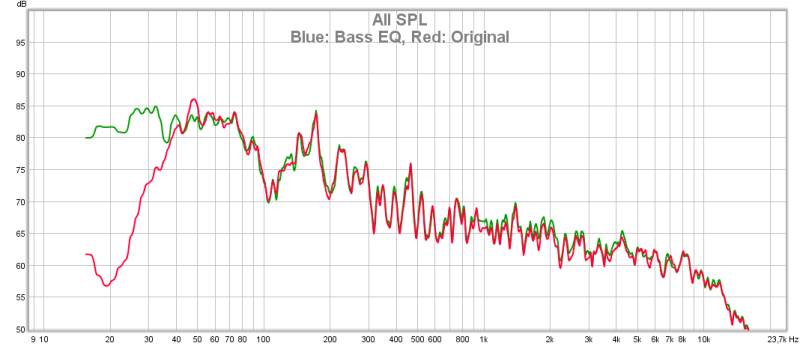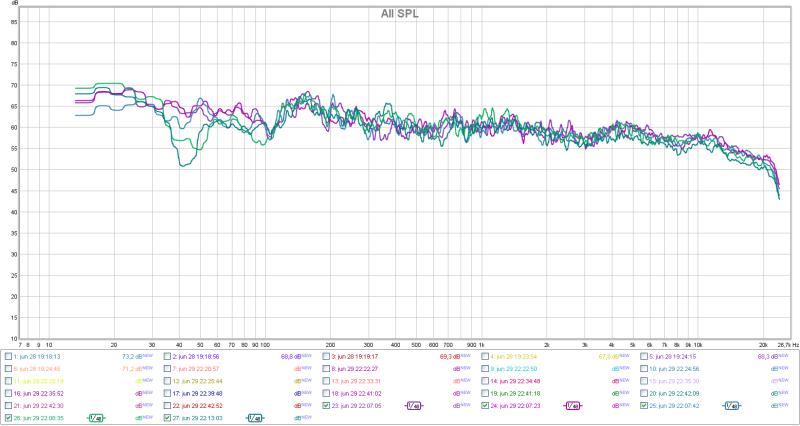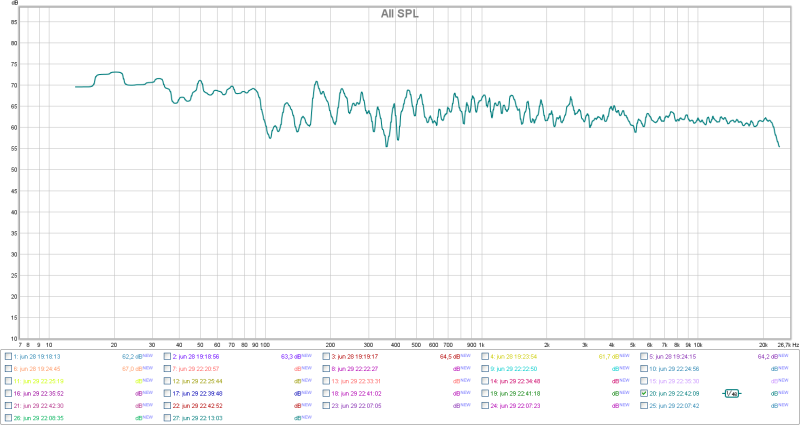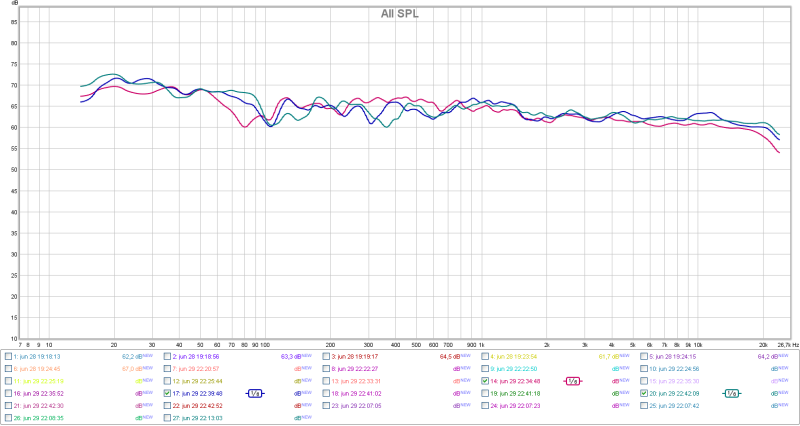Would it not be great if you could bring back the lost bass in you favorite movies?
Well, perhaps you can.
By applying equalization customized for each movie during playback, it is possible to dig out some of the low bass lost due to filtering and processing in the studio.
Why Bass EQ
When movies are mixed in the studio, the sound will be adjusted according to what they hear in that studio.
Sometimes limitations in the playback equipment, such as speaker system, will lead to adjustments that will compromise sound quality.
Typical examples of such undesired adjustments are high-pass filtering that removes the lowest frequency content.
On a limited system this may sound better, because the removal of content that can not be reproduced anyway will increase headroom for the mid and upper bass frequencies.
When played back on a full frequency range system the filtered version looses weight and impact, and also tend to sound less natural.
If this filtering is done in one of the very final stages of production, then it is a good possibility that at least some of the filtered content can be retrieved.
This is what Bass EQ tries to do.
The better your playback system is, and if you also like it loud, like 0dB/reference, then the difference will be very significant, and on some movies the whole experience is lifted to another level.
But also if you play at lower volumes, say -20dB, perhaps you have some smaller but still nice and good quality subwoofers, then the difference will most certainly be very noticeable.
This is not only about more shake and physical impact at house-wrecking volumes, the overall sound quality is improved when the natural wide frequency range of is restored.
Example frequency spectrum plots playing this scene from the movie Battleship:
Battleship, original and Battleship with Bass EQ playback:
There is a huge difference in output at low frequencies, and listening easily reveals that the perceived increase in sound quality is significant and very far from subtle.
How to Bass EQ
You must be able to implement equalization according to the Bass EQ graph for each individual movie.
This can be done in a DSP, if you have something like that in the playback chain.
In a bass-managed system the Bass EQ can be implemented on the subwoofer channel.
Computer playback is increasing in popularity, and it will eventually be the preferred playback device for all media content.
Then it is likely that equalization can be done very flexible and accurate using a plug-in or built-in processing in the player software.
JRiver media center is an example of player software that can do Bass EQ with individual settings for each move.
A simple graphical equalizer or bass tone control will not be able to provide Bass EQ.
To verify your equalizer setting you can play a pink noise file and compare the frequency responses - the unfiltered pink noise should be flat, and pink noise with Bass EQ should look similar to the Bass EQ curve.
Some movies require a very large boost at low frequencies, perhaps in the order +20dB gain below 20Hz.
This requires careful attention to what you are doing.
If such a filter is left in unintentionally, and you play a movie with flat full frequency content, something will overload.
Some movies are quite heavy in the mid bass region, equalizing this down will gain some headroom for the low bass as well as improving the overall spectral balance.
If there is noise at frequencies below usable output, say around 10Hz and below, then this can be removed using a high pass filter, and some more headroom is gained.
If the sound track is mixed very loud and dynamically compressed, there may not be enough headroom for the low bass we bring back, and the only solution is to reduce the level before applying the Bass EQ.
The lost gain is restored later in the chain, perhaps as simple as adjusting the master volume.
Exactly how this is done depends on what it used for equalization; different dsp and software may require different approaches.
How to recognize good candidates for Bass EQ and what to fix
Any movie where sound effects and bass is lacking in weight are potential candidates.
Looking at the Peak-Average graph from the The Low Frequency Content Thread (films, games, music, etc) thread can tell a lot about how a movie sounds.
Kon-Tiki is a film with a good sound track utilizing the whole frequency spectrum, observe that the curve is a slightly tilted line extending all the way down to the very lowest frequencies:
The storm scene has content all the way down:

This film does not need any Bass EQ.
Battleship has met with an accident somewhere in the sound-making process:
There is an obvious drop right below 35Hz, looks like a steep high-pass filter has been applied.
This is something to work on for Bass EQ.
A good target response is likely an approximately tilted straight line, that extends as low in frequency as possible.
Start with applying equalization that bring the Peak-Average curve closer to this straight tilted response.
Evaluation by listening is necessary to determine appropriate equalization, and care must be taken to ensure not to clip the signal anywhere in the chain.
How low in frequency should you try to equalize to flat.
Depends on the original sound design, and whether there is any content to dig out, it may be buried in noise at the very lowest frequencies.
Fixing something destroyed with a 30Hz filter and mangaging to retrieve flat down to 20Hz can make a huge difference.
If you can extend it down to around 15Hz, even better.
Below around 15Hz is questionable, certainly depends on your playback system, as tactile feedback from floor or moving house structure may be required to notice it at all.
The lower you go the greater the risc of amplifying noise instead of usable content, and if you can bring a sound track with virtually no low bass back to life with significant content down to 15Hz, I would say that is a very good achievement.
Gravity, opening scenes (RTA from playback):
This film has a droning, constant tone around 20Hz, as can be seen in the curve.
This is part of the sound design.
The level below 20Hz drops off very quickly, but it is not likely that equalization can bring improvements, because likely there is no content that has been removed.
The relationship between frequency and time dictates that continuous tones, which have a long time span, are narrow in frequency distribution.
Impulse like transients, like cannons and gunshots, have short time span and a wide frequency distribution.
If there are no impulses, there may not be low frequency content to retrieve.
When the Explorer is hit by the debris, there are sound effects added that adds to the sensation of the incident, these sounds are more dynamic and impulse-like:
The spectrum reveals that there is content below the 20Hz drone, and that this content may have been filtered using a steep high pass around 20Hz.
Gravity is another candidate for Bass EQ.
Avatar, flight scene (RTA from playback):
This scene sounds good, the feeling of realism and athmosphere is good.
Right at the end of this scene, where the plane drops down the cliff, there is a sense of weightlessness, making it feel like you are on the plane.
The spectrum reveals why this effect is so good - there is significant content at the very lowest frequencies, peaking around 13Hz.
Avatar, monster stomp-stomp (RTA from playback):
Here the stomps sounds rather boomy and does not have the appropriate feeling of weight and impact.
The spectrum reveals why - the low frequency content below 25Hz is removed.
Considering the previous flight scene, the conclusion is that finding the best Bass EQ for Avatar will be a compromise.
Some scenes could benefit from a huge low-frequency boost, but then other scenes would sound horrible with too much in the low end.
Movies improving with Bass EQ
There is now a thread at data-bass listing Movies with Bass EQ:
The Bass EQ for Movies thread
Data-bass also hosts lots of other content about movies, subwoofers and sound quality related topics.
The Low Frequency Content thread is a highly regarded source for information about movie sound tracks.
















































